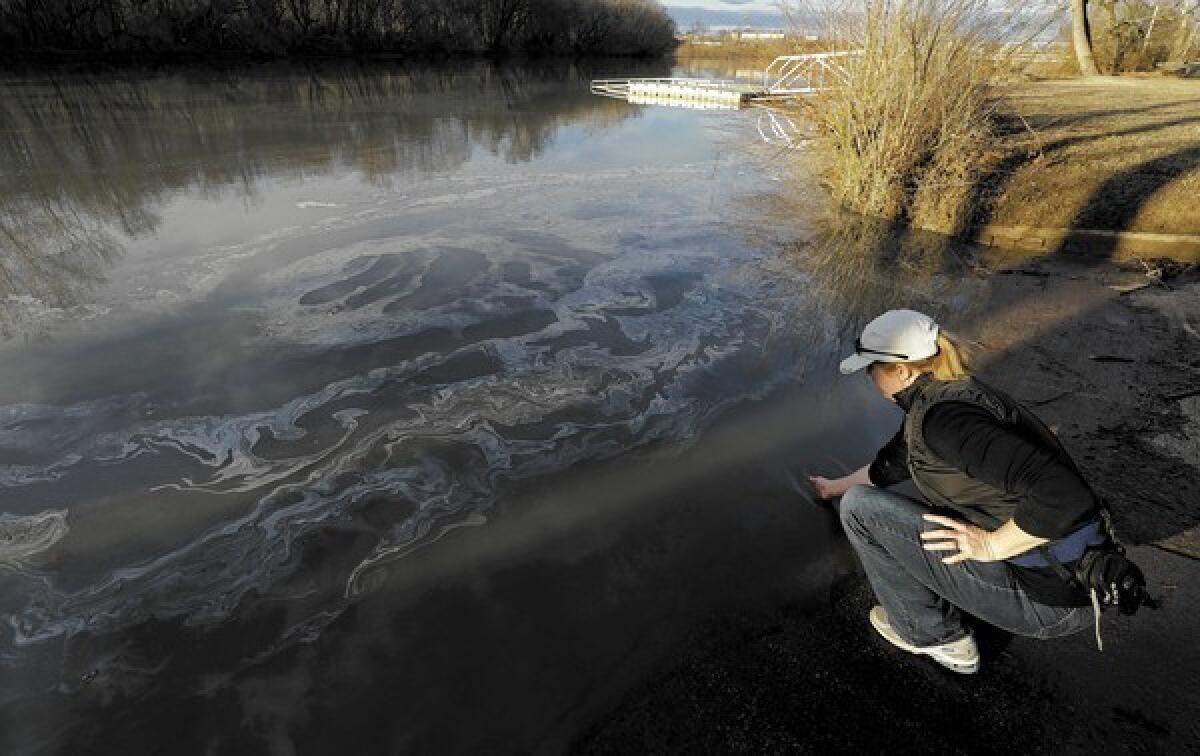North Carolina agency subject of U.S. inquiry over coal ash spill

DURHAM, N.C. — North Carolina’s environmental regulatory agency is under federal criminal investigation for its handling of a massive toxic coal ash spill into the Dan River near the Virginia border.
The U.S. attorney’s office in Raleigh issued a subpoena Monday that includes 13 separate requests for documents from the Department of Environment and Natural Resources related to Duke Energy and the spill, which was discovered Feb. 2. Tons of toxic heavy metals from a containment basin spilled into the river.
In the subpoena, obtained by The Times on Thursday, federal prosecutors say a grand jury in Raleigh is conducting “a criminal investigation of a suspected felony.” The four-page document requests agency records of its dealings with Duke Energy at its Dan River Steam Station plant in Eden, N.C., since 2010.
The subpoena requests all emails, memos and other documents that refer to “discharges or seepages from any coal ash pond” at the Dan River site. It seeks records of all correspondence with Duke Energy, as well as results of water-sample tests.
Duke Energy also received a federal grand jury subpoena Monday, according to Thomas C. Williams, a Duke spokesman. Williams said Duke would cooperate with the U.S. attorney’s office. He declined to provide details of the subpoena, saying it was confidential.
The subpoena the state environmental agency received requires its attorney to testify before the grand jury March 18. Thomas G. Walker, the U.S. attorney in Raleigh, did not respond to a request for comment.
Drew Elliot, a spokesman for the Department of Environment and Natural Resources, said the agency would cooperate with prosecutors.
Late Thursday, Duke announced that 1,000 gallons of treated sewage and storm runoff had been accidentally released into the Dan River next to the spill site. The utility said Tuesday’s spill posed no environmental danger. State regulators said they were investigating a possible violation of the Clean Water Act.
Environmental groups have accused the state agency of protecting Duke Energy, the country’s largest electric utility, and of failing to enforce laws against polluting waterways with coal ash. The groups attempted to sue Duke last summer, alleging that for years it has allowed toxic coal ash to seep into waterways from 14 coal-fired plants in the state.
The agency responded by filing four lawsuits against Duke for coal ash pollution, blocking the environmentalists’ suits. Lawyers for the environmental groups say the state lawsuits protected Duke from heavy fines for allegedly violating the federal Clean Water Act.
Earlier this week, the agency asked a judge to delay action on those suits, in which the state had reached a consent decree with Duke. Environmentalists note that the consent decree does not require the utility to clean up the coal ash basins.
The utility has said it notified regulators about the spill Feb. 2, the day it was discovered, but the utility waited 26 hours to notify the public. Environmental groups say the spill is the third largest in U.S. history.
Peter Harrison, an attorney with the Waterkeeper Alliance, which attempted to sue Duke, said the utility continued to pollute the state’s waterways at Dan River and other plants.
“The day of reckoning has come,” Harrison said in an interview Thursday, referring to the federal investigation. “It’s high time this activity by the state is examined through a criminal lens, because this is criminal behavior.”
Harrison said he had found evidence that coal ash from the containment pond was seeping into the Dan River above the Feb. 2 spill site. Water samples he took from the river about a third of a mile above the spill site show elevated levels of heavy metals contained in coal ash, including arsenic levels 18 times the human health standard and three times the water quality standard, he said.
Rocks in the river at the spill site are coated with orange residue from iron-oxidating bacteria in coal ash, indicating that ash has been seeping into the river there for years, Harrison said. He said he returned in a kayak four times to the site to see whether state regulators had attempted to stop the seepage, but the leak continued this week.
Harrison said he questioned officials from the state agency at a town meeting in Danville, Va., on Tuesday. The officials said they had no knowledge of the seepage and did not request additional details, he said.
The Waterkeeper Alliance also released results Thursday from its latest samples of river water at and below the spill site. They showed still-elevated levels of arsenic, lead, manganese and other toxic heavy metals.
Elliot, the state agency spokesman, said the site Harrison sampled probably contained “stormwater outfall.” He said EPA officials had tested the water there and found that the orange color came from naturally occurring iron bacteria or iron residue. State officials planned to test the water at the site as soon as winter weather permitted, Elliot said.
The state agency, which worked closely with Duke in response to the spill, has said its tests show that heavy metal levels in the river are within state standards for humans and wildlife. Duke has released similar results.
Test results released by the U.S. Environmental Protection Agency also show heavy metal levels within federal safety standards both downriver and upriver from the spill.
Both the state and Duke have downplayed the severity of the spill and assured residents that drinking water drawn from the Dan River is safe. Municipal water officials in Danville, the downriver city closest to the spill site, have said normal filtering has rendered the water safe to drink.
The state agency acknowledged Sunday that it had mistakenly reported that tests of water samples taken the day after the spill showed arsenic levels within state standards. Those results actually exceeded safety standards, the agency said, citing “an honest mistake.” Arsenic levels have since dropped within safety standards, the agency says.
However, the state agency warned the public Sunday — a week after the spill — to avoid contact with the river. On Wednesday, the state Department of Health and Human Services warned people not to eat fish or shellfish from the Dan River, and to avoid recreational activities there because of “a potential health hazard.”
This week, Duke announced that the amount of ash from the spill was smaller than the utility first reported — 30,000 to 39,000 tons, instead of the 50,000 to 82,000 first reported. Duke said 27 million gallons of contaminated coal ash basin water also spilled into the river.
The Waterkeeper Alliance disputed the latest totals. “Both Duke and DENR have repeatedly been wrong,” the group said in a statement, referring to the state regulatory agency.
“Whatever the actual amount, Duke Energy continues to pollute the Dan River due to its reckless way of storing coal ash,” the alliance said.
Since the 2012 election of Republican Gov. Pat McCrory, who worked for Duke Energy for 28 years, the Department of Environment and Natural Resources has adopted a pro-industry position. The agency secretary, John Skvarla, has said the department is a “partner” to those it regulates and considers them “customers.”
“The McCrory administration has allowed Duke Energy to act above the law,” Dean Naujoks of Yadkin Riverkeeper, a nonprofit environmental group, said Thursday.
McCrory, who waited four days to publicly discuss the spill, has declined to say whether the state will fine or sanction Duke for polluting the river. One state lawsuit accused Duke of “engineered discharges” of coal ash, but the state took no enforcement action to stop them.
Duke Energy says it has sealed the coal ash leak, from a broken stormwater pipe beneath the 27-acre coal ash containment basin. The utility says workers have pumped coal ash back into the basin, eliminating any leakage into the river. The Waterkeeper Alliance said Duke should have moved the ash to a more secure site farther from a waterway.
Duke said Thursday that its crews were removing coal ash from the riverbank and from river-bottom sediment, where heavy metals from coal ash have settled. “We will do whatever is needed to protect the river and aquatic life,” spokeswoman Erin Culbert said.
More to Read
Sign up for Essential California
The most important California stories and recommendations in your inbox every morning.
You may occasionally receive promotional content from the Los Angeles Times.











